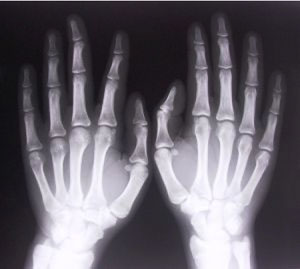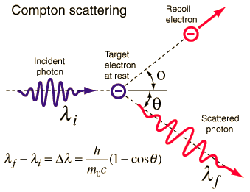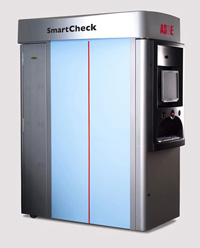In the post-September 11 era, engineers have developed new technologies to meet growing safety and security concerns at the world’s airports. The drawbacks of existing security measures – especially physical pat downs – have provided a foundation for “backscatter” X-ray technology. Information offered by the Transportation Security Administration and American Science and Engineering, Inc., demonstrate how backscatter X-ray devices combine basic physical concepts with established scanning technology to create a virtual strip search. The revealing images that are produced have raised concerns of privacy violations presented by this modern-day form of X-ray vision. The powerful potential of backscatter X-ray technology as a security system will ultimately depend on passengers’ trust of TSA officials and airport scanners.
Introduction

Adam Ciesielski/SXC
Figure 1: X-ray images show features below the skin.
X-ray vision: a phenomenon associated with the fantastic, the futuristic and, above all, the fictional. For many, the term alludes to Superman’s rare ability to see through walls in search of enemies or through clothing to find hidden weapons (Fig. 1). As mythical as X-ray vision seems, this ability has already been incorporated into modern reality-and the superhero responsible is the engineer.
Technology has played a significant role in the reorganization and advancement of airport security systems since the terrorist attacks of September 11 and the threats that ensued. The days of sporadic pat-downs and occasional bag scans have long since passed. Today, passengers arrive at airports over three hours before their flights in anticipation of long lines for metal detectors and luggage checks. The environment of fear developed after the World Trade Center and Pentagon attacks suspended concerns about the issue of privacy violation versus necessary precautions. However, recent advancements in airport security have reinstated these concerns with the introduction of “backscatter” X-ray technology.
Backscatter X-ray machines perform virtual strip-searches: air travelers are scanned from head to toe to produce a 360-degree image that literally sees through their clothes. While metal detectors only reveal metallic items, the high-resolution backscatter X-ray images disclose plastics, ceramics, and chemicals as well. This exposure, however, also comes with a detailed view of the traveler’s naked body, providing airport screeners with what some consider a too-realistic form of X-ray vision. The engineering of this controversial superpower combines fundamental physics concepts with innovative technology, fueling a renewed debate of privacy versus precaution at the airport.
Motivations for Better Technology
X-ray technology was integrated into medical CAT (Computerized Axial Tomography) Scans by Robert S. Ledley in 1975 and incorporated into airport security systems in the 1990s [1]. Today, X-ray scans are primarily performed on checked and carry-on luggage. The machines detect inorganic materials (plastics, ceramics, and metals) found inside a majority of containers, without exposing nearby operators and passengers to harmful amounts of radiation [2]. Since the 1990s, the Transportation Security Administration (TSA) has employed an X-ray device called the Explosive Detection System (EDS) in all airports, increasing distribution significantly since September 11 [3].
The accuracy of the EDS was debated even before the terrorist attacks on the World Trade Center and Pentagon [4]. The numerous security failures of September 11 and subsequent threats have spurred TSA to take action on pinpointing where shortcomings originate in the system. Studies have revealed that technological inadequacies of X-ray machines in scanning luggage have not been the cause of the inconsistencies. Rather, human error in screening passengers has proved to be a significant concern, as seen in TSA’s October 2006 tests at Newark Liberty International Airport. Newhouse News Service reported that screeners “missed fake explosive devices taped beneath an agent’s clothing and concealed under a leg bandage another tester wore.” Furthermore, screeners “failed to use handheld metal-detector wands when required, [and] missed an explosive device during a pat down” [5].
While a lack of training may be causing these failures, another source is the issue of privacy violation provoked by physical pat downs. Frisking, especially in the upper torso area on women, introduces difficult questions of sexual harassment. The situation is uncomfortable for both passengers and screeners, and has triggered complaints [6]. In an effort to eliminate this dilemma, TSA wants to limit human involvement in passenger screening, providing the motivation for backscatter X-ray machines.
X-rays and the Photoelectric Effect
An explanation of backscatter technology starts with two fundamental physical phenomena: X-rays and the photoelectrical effect. X-rays are a form of electromagnetic radiation, or light. They are composed of tiny energized particles known as photons that travel in a wavelike pattern [7]. In relation to visible light, X-rays have a shorter wavelength and higher frequency. X-ray frequencies vary from 1016 to 1021Hertz. As the frequency increases, the magnitude of energy of a wave’s photons increases. This direct relationship corresponds to how far an electromagnetic wave can penetrate an opaque surface. X-rays are located at the higher end of the spectrum, and thus they can pass through solid objects, such as clothes and skin, that visible light cannot.
How does a wave’s energy determine whether it will pass through or deflect off a surface? Upon interaction with an atom, photons can transfer their energy to one or more electrons, thereby elevating the latter to a higher energy state [8]. A photon’s ability to energize an electron depends on the frequency of the wave it travels in. This dependency is highly specific; transfers occur only when the energy of a certain frequency equals the energy between specific electron energy levels [9]. In other words, an X-ray will not energize an electron to a particular state (and thus will not be absorbed) if its frequency is too small or too large. This relationship is known as the photoelectric effect.
The absorption capability also depends on atomic structure. Smaller atoms (with lower atomic numbers) tend to hold on to their electrons more tightly, deflecting high frequency X-rays. Larger atoms (higher atomic numbers) absorb these high frequency X-rays since they have more electrons that are farther from the nucleus [8]. Thus, varying the frequency could allow X-rays to deflect off one surface and not another. In the case of airport security systems, this allows the penetration of clothing but not of skin and foreign objects.
Photons that are deflected off electrons follow a route known as the Compton Scattering Effect (see Fig. 2). This effect occurs when a photon does not completely transfer its energy to an electron with which it interacts. Instead, the electron absorbs a fraction of the particle’s energy and deflects an X-ray wave with a lower frequency. These lower-energy waves are known as “backscatter” X-rays and are often emitted by organic materials, or pure elements with low atomic numbers (e.g. hydrogen, oxygen, and carbon). Since explosives and threatening chemicals are composed of organic matter, backscatter waves are ideal for individually identifying these potential threats. Engineers have taken advantage of the Compton Scattering Effect by developing systems that recognize backscatter X-rays that correspond with specific organic materials.

Hyperphysics/Georgia State University
Figure 2: Compton Scattering describes the effect of electrons absorbing a fraction of a particle’s energy and deflects an X-ray of lower frequency.
SmartCheck’s Virtual Strip Search
The TSA’s desire for a security device that minimizes human involvement inspired several companies to take up the challenge of creating a virtual strip search. In 2002, American Science and Engineering, Inc., (AS&E) presented the TSA with SmartCheck (see Fig. 3), a personnel inspection system designed to detect “both metallic and non-metallic objects, such as guns and knives, plastic and liquid explosives, composite weapons, drugs and other hidden threats and contraband” [10]. This $100,000 system uses AS&E’s Z Backscatter technology to provide an “easy-to-read” display of hidden weapons or contraband (see Fig. 3).

American Science and Engineering, Inc./SmartCheck
Figure 3: The SmartCheck Personnel Screening System is a personnel X-ray screening system designed to detect all objects that a person may be carrying on their body.
Z Backscatter technology takes advantage of the Compton Scattering Effect by detecting and identifying various frequencies of backscatter X-rays. The deflection pattern of X-rays depends on the material it encounters. Explosives, plastic weapons and drugs consist of organic materials such as oxygen, carbon, nitrogen and hydrogen. These materials have a low density and thus a low atomic number, indicated by the atomic symbol “Z” in Z Backscatter [11]. The small atoms deflect high energy backscatter X-rays at different frequencies. Two detection meters then pick up transmitted and deflected frequencies and note the discrepancies. The frequencies are specific enough to recognize organic elements up to and including the skin, thus providing a detailed image of the body, including genitalia [12].
Using reverse detection techniques, SmartCheck can also identify inorganic materials. Not only does the system produce bright, well-defined imagery with the recognition of scattered X-rays, but it also can recognize the absence of deflected waves. High-density (high atomic number) materials such as metal weapons and wiring appear as dark spots on scans next to brighter low-density visuals [11]. Z Backscatter technology can differentiate between varying compositions based on detected backscatter frequencies, and label them on the computer monitor accurately. Thus, SmartCheck combines the metal detector with a virtual pat down into a roughly one-minute-long process [13].
Health and Safety Concerns
The exposure of passengers to high-energy X-ray beams calls into question the unhealthy side-affects of radiation from devices such as SmartCheck. According to the National Council on Radiation Protection and Measurements (NCRP), a “Negligible Individual Dose” is defined as 1 millirem per year and per source [14]. Daniel Strom of the Health Physics Society reports that a single scan for a backscatter X-ray device would expose an individual to 0.005 millirem per scan. Thus, it would require 200 screening scans in a year to reach a noteworthy dosage – an “improbably high number for anyone,” as Strom contends.
Precaution versus Privacy
The detailed images of the human body that are produced by backscatter X-ray devices also raise concerns regarding passenger privacy. As a result of these complaints, TSA and companies such as AS&E have worked together to provide certain privacy benefits to travelers. SmartCheck has implemented software in its Z Backscatter technology that provides a privacy filter that displays only an outline of the scanned individual.
In 2005, the Electronic Privacy Information Center (EPIC) questioned whether unedited images could be obtained and stored by the device and thus be available to the screener at a later point in time. To address this concern, the organization assured that the “capability of printing, storing or transmitting the image is not available to the TSA officer operating the system” [15]. Furthermore, the computerized system will be isolated from a network, and only one TSA official will be able to operate it at a single time. The officer attending to the passenger will have no access to the image, to further eliminate discomfort. Kip Hawley, an administrator with the agency, acknowledged that privacy and security are not mutually exclusive, and that backscatter still “has potential to be a valuable tool in our layered security approach.” Hawley also mentioned that there will be “opportunity for continued public dialogue [to] see how this technology works in the airport setting” [16].
SmartCheck and other backscatter devices are currently being tested in major airports in the United States and Europe. Phoenix Sky Harbor Airport has already implemented the device into its operations, earning an overall “good” reaction from tested passengers, according to AS&E Vice President of Marketing, Joe Reiss [16]. Los Angeles International and New York’s John F. Kennedy airports are next in line to test the device in secondary screening efforts. With these trials, TSA officials hope to gauge the effectiveness of backscatter technology against public response to this seemingly invasive technique.
The debate over privacy, respect, and backscatter X-ray technology thus comes down to trusting TSA’s promise to passengers. Backscatter X-ray scans are currently voluntary and secondary screening procedures; a passenger’s alternative is a physical pat down. Both options present significant privacy concerns and have limitations. Low X-ray frequencies that meet “negligible” radiation standards limit screeners from viewing weapons hidden in body folds or cavities [12]. Frisking depends on the effectiveness and training of the security official performing the pat down. By enabling the passenger to choose, TSA recognizes the controversy posed by both forms of security, and ultimately leaves the debate open to individual travelers.
Other Uses of Backscatter Technology
While privacy concerns have hindered the widespread use of backscatter X-ray machines in passenger scanning, this technology has demonstrated its value in scanning luggage and vehicles for explosive material. EDS technology penetrates dense materials to produce “shadowgram” images, similar to those produced by medical radiology. However, this system is limited to detecting only transmitted X-ray frequencies. AS&E thus incorporated Z Backscatter technology into the EDS, providing detection systems for both transmitted and deflected X-rays. The new system highlights and classifies organic and inorganic materials to expedite the scanning process. AS&E’s devices enable security officials to scan any size object, from small carry-on luggage to semi-trucks [11].
Conclusion
Backscatter X-ray technology demonstrates progress in airport safety and security while renewing questions regarding the privacy rights of individuals. This realistic form of X-ray vision has the potential to become a true superpower for airport security engineers. However, while Superman may have reserved his ability for good, the employment of backscatter technology does not have such guaranteed results in today’s world. It will ultimately be up to screeners and TSA officials to earn the trust of wary passengers.
References
-
- [1] M. Bellis. “The Invention of X-Ray Machines and CAT Scans.” About, Inc., Internet: http://inventors.about.com/library/inventors/blxray.htm, June 18, 2007.
- [2] E. Grabianowski and J. Tyson. “How Airport Security Works”. Internet: http://travel.howstuffworks.comairport-security4.htm, June 20, 2001.
- [3] “Explosive Detection System: Innovation and Technology.” Transportation Security Administration. Internet: http://www.tsa.gov/approach/tech/eds.shtm, June 18, 2007.
- [4] T. Beardon. “Safe Enough?” Internet: http://www.pbs.org/newshour/bb/transportation/september96/safety_9-3.html, September 3, 1996.
- [5] R. Marisco. “Airport Screeners fail to see most test bombs.” Newhouse News Service. Internet: http://www.rawstory.com/showoutarticle.php?src=http%3A%2F%2Fseattletimes.nwsource.com%2Fhtml%2Fnationworld%2F2003327485_screeners28.html, October 28, 2006.
- [6] S. Levine. “Software and Smartcards: Can technology improve airport security while reducing the hassles for passengers?” U.S. News and World Report. Internet: http://www.usnews.com/usnews/news/articles/050314/14airport.htm, March 6, 2005.
- [7] S. Sample. “The Electromagnetic Spectrum: X-rays.” National Air and Space Administration. Internet: http://science.hq.nasa.gov/kids/imagers/ems/xrays.htm, March 27, 2007.
- [8] Department of Physics and Astronomy, Arizona State University. “Visible Light and X-rays.” Internet: http://acept.asu.edu/PiN/rdg/visnxray/visnxray.shtml, December 21, 1999.
- [9] T. Harris. “How X-rays Work”. Internet: http://www.howstuffworks.comx-ray.htm, March 26, 2002.
- [10] “SmartCheck: Personnel Inspection System.” American Science and Engineering, Inc. Internet: http://www.as-e.com/products_solutions/smart_check.asp, 2007.
- [11] American Science and Engineering, Inc. “Z Backscatter.” Internet: http://www.as-e.com/products_solutions/z_backscatter.asp, June 18, 2007.
- [12] Electronic Privacy Information Center. “Spotlight on Surveillance.” Internet: http://www.epic.org/privacy/surveillance/spotlight/0605/, June 2005.
- [13] D. Irvine. “Airport officials get X-ray vision.” CNN, March 6, 2007.
- [14] D. Strom. “Screening Individuals with Backscatter X-Ray Systems.” Health Physics Society, February 12, 2007.
- [15] Transportation Security Administration. “Backscatter Technology Balances Privacy and Security.” Internet: http://www.tsa.gov/what_we_do/screening/backscatter.shtm, June 18, 2007.
- [16] S. Smith. “To See or Not to See?” Internet: http://www.respondersafetyonline.com/500/Issue/Article/False/47200/Issue, March 30, 2007.

